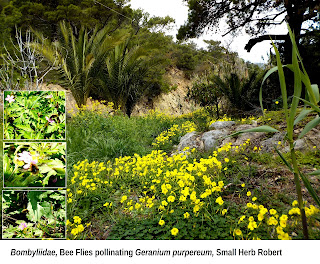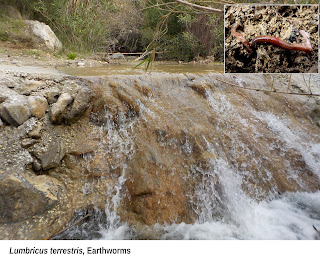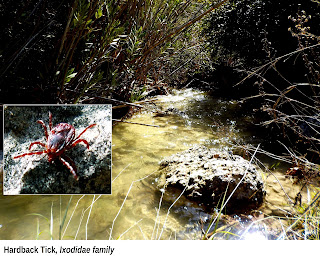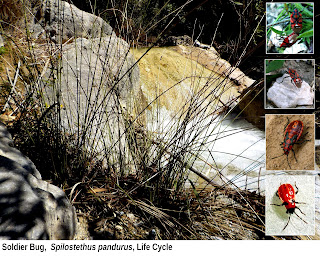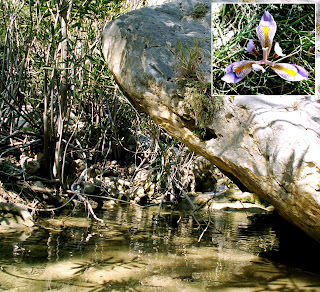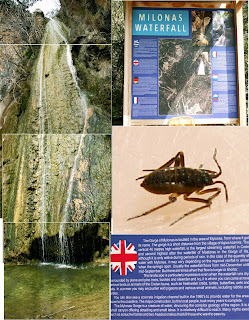We’ve had rather a lot of rain recently but before we go down and see what effect it has had on our stream I noticed this little patch of ground when we emerged onto the track last week. It is regularly cultivated later in the spring but let’s have a look and see what’s taken hold before the rotavator moves in. Plenty of Wood Sorrell here at our feet and some stands of White Mustard in front of the Date Palms but just check out these little pink flowers. These are Small Herb Robert and they are certainly attracting the little Bee Flies. As their name suggests they are flies that have evolved to protect themselves by looking like bees. Whenever you come across an animal that seems to have two contradictory names the second name tells you what it is and the first name tells you what it resembles. Thus a Whale Shark is a shark that resembles a whale and a Curlew Sandpiper is a sandpiper that looks like a curlew and not the other way around.
The rain has certainly put a bit more vim and
vigour into our stream; it looks as though it can’t wait to get to the sea.
Let’s have a dig along the bank and see what turns up. Earthworms – now these
are quite exciting for me because I don’t see many in our arid climate out
here. The one on the right is an adult Lobworm and the one on the left looks to
be a juvenile. How can you tell the difference? Earthworms are hermaphrodite
(both male and female) and when they mature they develop a ‘saddle’,
technically called the clitellum, which contains the eggs. After two earthworms
have mated the sperm from worm 1 is transferred up the body of worm 2 to the
saddle (and vice-versa), the clitellum secretes material that forms a ring
which the worm then slides out of and injects the eggs and sperm into it. The
ring seals itself into a cocoon in which the baby worms develop, emerging as
fully formed juveniles two or three months later. Now you know all about the
sex life of the earthworm. You’ve always wanted to know that, haven’t you?
I see that we have a diminutive cascade running
into our stream from the valley side. Do you fancy a climb? We could do with a
change of scene. There are quite a number of White Hedge-nettles about: another
totally misleading name as they are not nettles at all and they don’t always
grow in hedges as you can see. If you look at the flower shape you can see that
they are similar in design to Sage, Rosemary and many of the other culinary
herbs and that is because they are in the same family. Nettles are in a
completely different family and their flowers are totally dissimilar and very
dull in comparison. Mind you, you can eat nettles but as far as I know there
are no recipes for White Hedge-nettles despite their family connections. That
may be one for our friend Haris Saslis at Forage Crete to investigate.
Here’s another one of those pesky flies trying to
look like something it isn’t. It has all the colouring and shape of a wasp but
it’s a Hoverfly. This one is male and they usually appear earlier in the spring
than the females giving them a chance to mature (you know how long it takes us
boys to grow up –I’m not sure I’ve got there yet). How do I know it’s a male?
The eyes are set very close together and appear to almost join in the middle.
In the female the eyes are set further apart.
 Quite a nice view of the opposite side of the
valley from up here and we’re almost back to the coast. Look back down to the
track a moment. There, sitting on top of that telegraph pole – a kestrel. They
often patrol up and down this valley. They’ll be breeding soon, nesting in
holes and scrapes in the cliffs or maybe in an old crow’s nest. They can lay up
to six or seven eggs and like many birds they are r-strategists. That is they
spread their parental care over a number of offspring allowing the strongest to
survive. This compares to animals like ourselves who are k-strategists (in the
developed world at least) who have fewer offspring but devote considerable care
and attention to ensuring that they all survive. I sometimes wonder, from a
purely biological rather than a humanitarian viewpoint, whether we in the
developed world are correct in imposing our k-strategy thinking on those parts of
the world where the r-strategy prevails.
Quite a nice view of the opposite side of the
valley from up here and we’re almost back to the coast. Look back down to the
track a moment. There, sitting on top of that telegraph pole – a kestrel. They
often patrol up and down this valley. They’ll be breeding soon, nesting in
holes and scrapes in the cliffs or maybe in an old crow’s nest. They can lay up
to six or seven eggs and like many birds they are r-strategists. That is they
spread their parental care over a number of offspring allowing the strongest to
survive. This compares to animals like ourselves who are k-strategists (in the
developed world at least) who have fewer offspring but devote considerable care
and attention to ensuring that they all survive. I sometimes wonder, from a
purely biological rather than a humanitarian viewpoint, whether we in the
developed world are correct in imposing our k-strategy thinking on those parts of
the world where the r-strategy prevails.
And on that thought I think we’ll call it a day and
make our way back down to the track. Watch your footing, going down can be more
treacherous than climbing up and I don’t want to pick you up in a heap at the bottom.
The Extra Bit
Just in
case these blog posts give you a taste for visiting the Mediterranean I am
hosting a new facebook site called Mediterranean Island Insights which features
posts from bloggers on various Mediterranean Islands. Here is the link: https://www.facebook.com/groups/1309179912496006/
*********************************************************************
LINKS:
Naturalists
(the facebook page that accompanies this blog)
See detailed pictures at
http://www.inaturalist.org/login (search - people-stevedaniels-observations)
